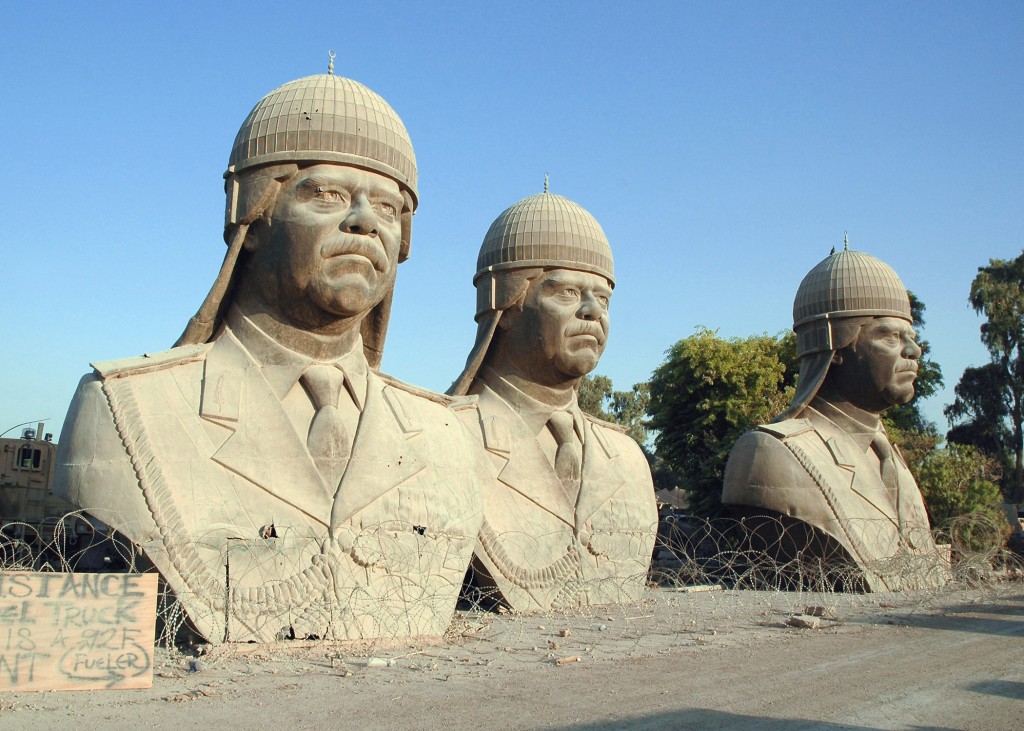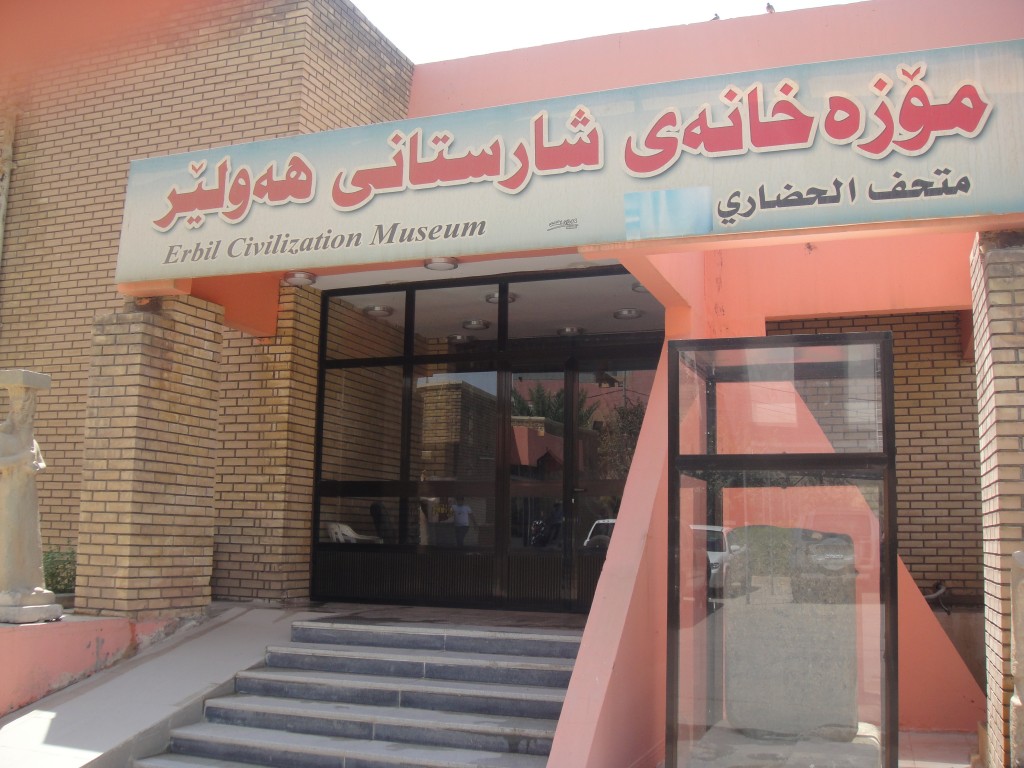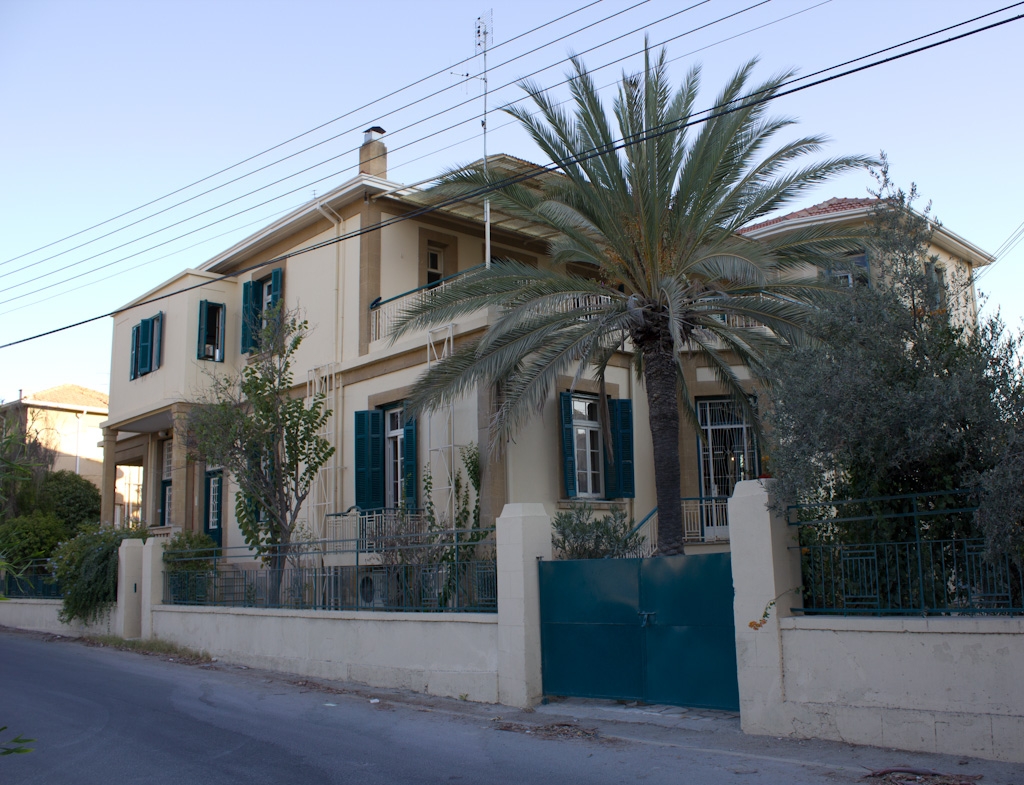
Thirty-foot tall bronze sculptures of former Iraqi Saddam Hussein, sit on the grounds of the Republican Palace, in the International Zone (IZ) located in Central Baghdad, Iraq. (DoD photo by Jim Gordon, CIV)
By: Morag M. Kersel and Christina Luke
Ten years ago, in April of, a coalition led by the United States invaded Iraq. This quickly toppled the Ba’athist regime of Saddam Hussein but also resulted in the loss of life, local unrest, displacement, and the ransacking of cultural institutions, archives, libraries, and the national museum in Baghdad. During that eventful month we both worked for the U.S. Department of State in the Cultural Heritage Center– Christina as a cultural property analyst and Morag as a contractor, administering the U.S. Ambassadors Fund for Cultural Preservation.
In our daily work lives at State we knew that we were carrying out foreign policy initiatives under the guise of archaeology, but until April ofand the unfolding events in Iraq we did not realize that all of the programming and initiatives we carried out at State, and much of our previous lives as archaeologists, was in the service of the state, under a paradigm of national bridge building and fence mending. While we do not wish to diminish the myriad devastating effects of war on humanity, as archaeologists we are also concerned with the consequences of war on cultural heritage.
The days following the invasion were action-packed, filled with discussions and consultations on the best courses of action to protect cultural heritage sites, how to recover and repatriate artifacts looted from sites and museums, and how best to work with our archaeological and cultural heritage counterparts in academic institutions, non-governmental entities, and at the State Board of Antiquities and Heritage [SBAH] in Iraq. After three years of working with/for the Department of State, one thing became very clear to us: archaeology and archaeologists are key elements in the U.S. diplomatic toolkit. Archaeology and archaeologists are among the everyday, on the ground diplomats who present the non-military face of the U.S. to the world at large.
In the days after initial reports of looting and ransacking of cultural institutions, archaeological sites, and museums in Baghdad and the countryside, coalition forces and the U.S.in particular were excoriated in the press. The public woke up to front page headlines like “US Blamed for Failure to Stop Sacking of Museum” and “The greatest cultural disaster of the last 500 years.” The negative publicity associated with the failure of coalition forces to protect the cultural resources in the “cradle of civilization” sent foreign opinion of the United States into a tailspin. Most of the world believed that the U.S. did not care about culture and our failure to place a tank in front of the national museum, but choosing to protect the oil ministry, reinforced this notion. How could a country overcome such damaging allegations?
Enter the Cultural Heritage Center of the U.S. Department of State. In the decade afterwe have witnessed the transition of an office that had been working quietly and diligently behind the scenes with little recognition or support to an entity that has become, by cultural heritage standards, a major funding source, intellectual resource, and a prominent player in establishing U.S. approaches to cultural policy and programs on the international level. Since the initial failure to safeguard the cultural sites and institutions in Iraq, the Cultural Heritage Center has earmarked funds, established collaborative training programs, supported conservation efforts, museum exhibitions, and archaeological site management plans. All of these help demonstrate that the U.S. does care about culture and global heritage.

Erbil Civilization Museum – image courtesy of the Iraqi Institute of Antiquities and Heritage in Erbil
Over the years the Iraq Cultural Heritage Initiative has received some US $12.9 million for various cultural heritage projects in Iraq. Funds have been used for infrastructure improvements to the Iraq Museum in Baghdad and the rebuilding of museums and archaeology organizations as well as the creation of a conservation institute in Kurdish-populated Erbil. Training of Iraqi scientists in the United States and in Iraq is also an essential element of the Iraq Cultural Heritage Initiative.
We argue that this project is an element of American statecraft, which allows the U.S.to project a kinder, gentler side of foreign relations. Archaeologists in both the West and in Iraqare often called on to promote mutual understanding and a shared goal of protecting the past. Programs like this and others administered by the Cultural Heritage Center at State are not only about atonement for past carelessness, they are mutually advantageous – the typical U.S. archaeologist can and does profit from these associations just as the average Iraqi archaeologist benefits. Recently, the first official SBAH permits to conduct archaeological excavation and survey in the south of Iraq were issued to joint Iraqi-foreign teams. These permits were issued as part of the Iraq Cultural Ministry’s recognition of countries that assisted in recovering, repatriating, and safeguarding the country’s archaeological treasures. Despite this the question of political authority regarding who in Iraq has the right to issue permits to foreigners to work in the country has reared its head. Foreign teams seeking entry sometimes wait in limbo as Iraqi professionals grapple with issues of jurisdiction and oversight at archaeological sites.
But what does any of this have to do with the average American, or even the average U.S. archaeologist? In our recent publication US Cultural Diplomacy and Archaeology: Soft Power, Hard Heritage (Routledge) we argue that archaeology and archaeologists are deployed in the service of U.S. diplomacy abroad. We contend that foreign relations in places like Iraq and Afghanistan would be less well-developed without the positive, collaborative outcomes of archaeology and the efforts of U.S. field archaeologists working in partnership with professional archaeologists, government representatives, and local individuals.
Funding archaeological field research in order to improve understanding of our collective heritage is not cheap and it is often U.S. taxpayer dollars through programs from the U.S. Department of State, the Fulbright program, the National Science Foundation (NSF), the National Endowment for the Humanities (NEH), and the Council for Overseas American Research Centers (CAORC), that enable field projects to go ahead. We believe such fieldwork results in improved diplomatic relations between the United States and foreign partners. Unfortunately, precisely because most of these projects are “under the radar” and “soft,” they don’t make headlines, nor do they necessarily garner the same level of interest they would if they produced a high-impact economic return. Measuring the so-called “deliverables” is challenging. Our current work focuses on the legacy of archaeology and its long-term, sustained contributions to international diplomacy, technology, education, and in-country development.

W.F. Albright Institute in Snow – image courtesy of George Pierce, ECA Fellow, W.F. Albright Institute
Yet the future of archaeological field research is under threat. The current U.S.government fiscal crisis threatens to cut valuable funding from the NSF, the NEH, the CAORC, as well as the Fulbright program. If you care about the value of the archaeological past and its positive role for creating opportunities in the present, we urge you to become “archaeolobbyists” on behalf of various government programs that fund not only archaeology, but our critical nodes of support, especially the U.S. overseas research centers (more commonly known as the “foreign schools”). Places like the W.F. Albright Institute of Archaeological Research in Jerusalem, the Cyprus American Archaeological Research Institute in Nicosia, the American School of Classical Studies at Athens, the American Research Institute in Turkey (Ankara and Istanbul branches), and the American Center of Oriental Research in Amman are vital for presenting a neutral space for local and U.S. researchers to meet, debate, and plan future collaborations in cultural heritage. Funding for these institutions dropped in the last few years, so we ask you to call your local and state representatives and make the case for the importance of archaeology and archaeologists in global perceptions of a caring United States.
Many an archaeologist will declare that they do not “do politics” or “heritage.” To many, the science of archaeology allows them to remain above the political fray. We argue to the contrary, that support of scientific endeavors, especially with U.S. governmental sources, is steeped in politics. We think it is time that as a discipline we recognize the power of archaeology in diplomatic relations, whether it is through advancements in technologies using CORONA imagery, research focused on sustainable agriculture and climate change, or heritage management. The interdisciplinary and international networks of field archaeologists leverage cultural capital in ways that other disciplines cannot. This component represents our greatest strength in making the case for future funding of U.S. overseas archaeological projects and U.S. foreign centers. Archaeology and archaeologists are effective but undervalued elements of foreign relations that we should be championing.
Morag M. Kersel is assistant professor in the Anthropology Department at DePaul University and a member of the ASOR Program Committee. Christina Luke is senior lecturer in the Archaeology Department at Boston University and is the Chairperson of the Committee on Archaeological Policy of the Archaeological Institute of America. They are the co-authors of the recently published US Cultural Diplomacy and Archaeology: Soft Power, Hard Heritage (Routledge).
If you liked this article please sign up to receive The Ancient Near East Today via email! It’s our FREE monthly email newsletter. The articles will be delivered straight to your inbox, along with links to news, discoveries, and resources about the Ancient Near East. Just go here to sign up.
All content provided on this blog is for informational purposes only. The American Schools of Oriental Research (ASOR) makes no representations as to the accuracy or completeness of any information on this blog or found by following any link on this blog. ASOR will not be liable for any errors or omissions in this information. ASOR will not be liable for any losses, injuries, or damages from the display or use of this information. The opinions expressed by Bloggers and those providing comments are theirs alone, and do not reflect the opinions of ASOR or any employee thereof.

very nice. more power to you
Pingback: Coping: Rambling Investigations - UrbanSurvival